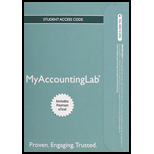
Concept Introduction:
Bonds payable:
The bonds payable can be defined as the instruments that enables the businesses to raise funds for their day to day business operations or any other financial needs like purchase of fixed assets – land, building, equipment etc.
If bonds are issued for more than their par value, it is said that they are issued at premium. The amount over and above the par value is premium amount.
If bonds are issued for less than their par value, it is said that they are issued at discount. The amount less than the par value is discount amount.
Requirement 1
a. Maturity
b. Carrying amount of the bonds at December 31, 2018
c. Semi-annual cash interest payment on the bonds
d. Interest Expense should the company record each year
Requirement 2
To prepare:
Want to see the full answer?
Check out a sample textbook solution
Chapter 14 Solutions
MyLab Accounting with Pearson eText -- Access Card -- for Horngren's Accounting
- Union National Bank has an issue of preferred stock with a $6.20 stated dividend that just sold for $105 per share. What is the bank’s cost of preferred stock? Financial accounting problemarrow_forwardI need assistance with this general accounting question using appropriate principles.arrow_forwardgive me solution plzarrow_forward
- What is the amount of total assets?arrow_forwardA man earned wages of $52,800, received $1,600 in interest from a savings account, and contributed $4,200 to a tax-deferred retirement plan. He was entitled to a personal exemption of $3,700 and had deductions totaling $5,400. Find his gross income, adjusted gross income, and taxable income. Accurate answerarrow_forwardCalculate depreciation expense on the machinearrow_forward
- Please provide the correct answer to this general accounting problem using accurate calculations.arrow_forwardHarlow Co. is a merchandising company. Last month the company's cost of goods sold was $65,200. The company's beginning merchandise inventory was $12,500 and its ending merchandise inventory was $22,400. What was the total amount of the company's merchandise purchases for the month? Need answerarrow_forwardFinancial accounting 12arrow_forward
- Financial accounting 34.67.89arrow_forwardPlease provide the solution to this general accounting question using proper accounting principles.arrow_forwardHarlow Co. is a merchandising company. Last month the company's cost of goods sold was $65,200. The company's beginning merchandise inventory was $12,500 and its ending merchandise inventory was $22,400. What was the total amount of the company's merchandise purchases for the month? Helparrow_forward

 AccountingAccountingISBN:9781337272094Author:WARREN, Carl S., Reeve, James M., Duchac, Jonathan E.Publisher:Cengage Learning,
AccountingAccountingISBN:9781337272094Author:WARREN, Carl S., Reeve, James M., Duchac, Jonathan E.Publisher:Cengage Learning, Accounting Information SystemsAccountingISBN:9781337619202Author:Hall, James A.Publisher:Cengage Learning,
Accounting Information SystemsAccountingISBN:9781337619202Author:Hall, James A.Publisher:Cengage Learning, Horngren's Cost Accounting: A Managerial Emphasis...AccountingISBN:9780134475585Author:Srikant M. Datar, Madhav V. RajanPublisher:PEARSON
Horngren's Cost Accounting: A Managerial Emphasis...AccountingISBN:9780134475585Author:Srikant M. Datar, Madhav V. RajanPublisher:PEARSON Intermediate AccountingAccountingISBN:9781259722660Author:J. David Spiceland, Mark W. Nelson, Wayne M ThomasPublisher:McGraw-Hill Education
Intermediate AccountingAccountingISBN:9781259722660Author:J. David Spiceland, Mark W. Nelson, Wayne M ThomasPublisher:McGraw-Hill Education Financial and Managerial AccountingAccountingISBN:9781259726705Author:John J Wild, Ken W. Shaw, Barbara Chiappetta Fundamental Accounting PrinciplesPublisher:McGraw-Hill Education
Financial and Managerial AccountingAccountingISBN:9781259726705Author:John J Wild, Ken W. Shaw, Barbara Chiappetta Fundamental Accounting PrinciplesPublisher:McGraw-Hill Education





